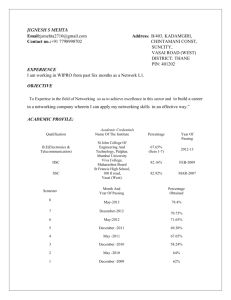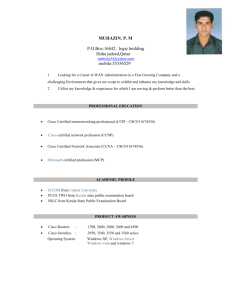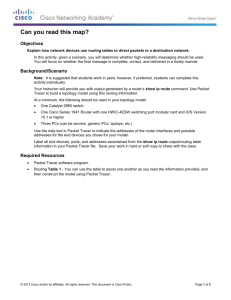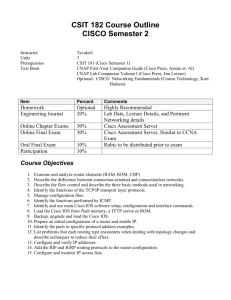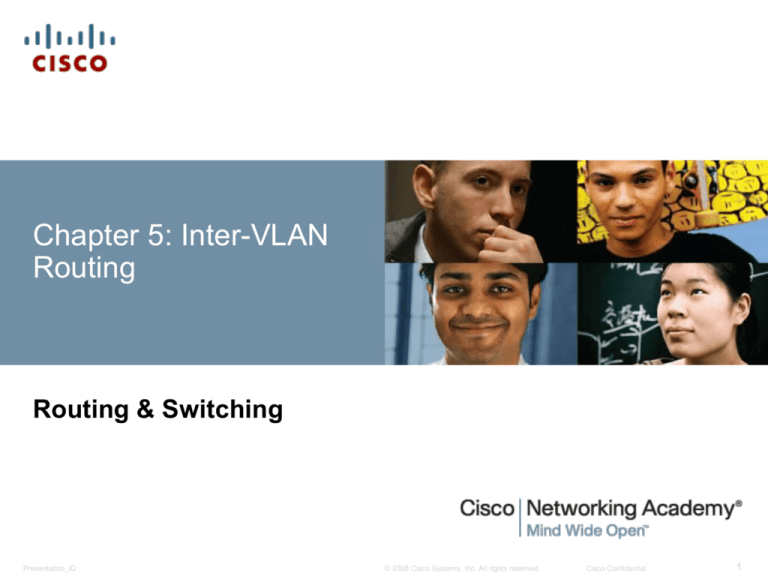
Chapter 5: Inter-VLAN
Routing
Routing & Switching
Presentation_ID
© 2008 Cisco Systems, Inc. All rights reserved.
Cisco Confidential
1
Chapter 5
5.1 Inter-VLAN Routing Configuration
5.2 Troubleshooting Inter-VLAN Routing
5.3 Layer 3 Switching
5.4 Summary
Presentation_ID
© 2008 Cisco Systems, Inc. All rights reserved.
Cisco Confidential
2
Chapter 5: Objectives
Describe the three primary options for enabling inter-VLAN routing.
Configure legacy inter-VLAN routing.
Configure router-on-a-stick inter-VLAN routing.
Troubleshoot common inter-VLAN configuration issues.
Troubleshoot common IP addressing issues in an inter-VLAN-routed
environment.
Configure inter-VLAN routing using Layer 3 switching.
Troubleshoot inter-VLAN routing in a Layer 3-switched environment.
Presentation_ID
© 2008 Cisco Systems, Inc. All rights reserved.
Cisco Confidential
3
5.1 Inter-VLAN Routing
Configuration
Presentation_ID
© 2008 Cisco Systems, Inc. All rights reserved.
Cisco Confidential
4
Inter-VLAN Routing Operation
What is Inter-VLAN routing?
Layer 2 switches cannot forward traffic between VLANs without the
assistance of a router.
Inter-VLAN routing is a process for forwarding network traffic from
one VLAN to another, using a router.
Presentation_ID
© 2008 Cisco Systems, Inc. All rights reserved.
Cisco Confidential
5
Inter-VLAN Routing Operation
Legacy Inter-VLAN Routing
In the past:
Actual routers were used to route between VLANs.
Each VLAN was connected to a different physical router interface.
Packets would arrive on the router through one through interface,
be routed and leave through another.
Because the router interfaces were connected to VLANs and had
IP addresses from that specific VLAN, routing between VLANs was
achieved.
Large networks with large number of VLANs required many router
interfaces.
Presentation_ID
© 2008 Cisco Systems, Inc. All rights reserved.
Cisco Confidential
6
Inter-VLAN Routing Operation
Router-on-a-Stick Inter-VLAN Routing
The router-on-a-stick approach uses a different path to route
between VLANs.
One of the router’s physical interfaces is configured as a 802.1Q
trunk port so it can understand VLAN tags.
Logical subinterfaces are created; one subinterface per VLAN.
Each subinterface is configured with an IP address from the VLAN it
represents.
VLAN members (hosts) are configured to use the subinterface
address as a default gateway.
Only one of the router’s physical interface is used.
Presentation_ID
© 2008 Cisco Systems, Inc. All rights reserved.
Cisco Confidential
7
Inter-VLAN Routing Operation
Multilayer Switch Inter-VLAN Routing
Multilayer switches can perform Layer 2 and Layer 3 functions,
replacing the need for dedicated routers.
Multilayer switches support dynamic routing and inter-VLAN routing.
The multilayer switch must have IP routing enabled.
A switch virtual interface (SVI) exists for VLAN 1 by default. On a
multilayer switch, a logical (layer 3) interface can be configured for
any VLAN.
The switch understands network-layer PDUs; therefore, can route
between its SVIs, just as a router routes between its interfaces.
With a multilayer switch, traffic is routed internal to the switch device.
This routing process is a suitable and scalable solution.
Presentation_ID
© 2008 Cisco Systems, Inc. All rights reserved.
Cisco Confidential
8
Configure Legacy Inter-VLAN Routing
Preparation
Legacy inter-VLAN routing requires routers to have multiple
physical interfaces.
Each one of the router’s physical interfaces is connected to a
unique VLAN.
Each interface is also configured with an IP address for the subnet
associated with the particular VLAN.
Network devices use the router as a gateway to access the
devices connected to the other VLANs.
Presentation_ID
© 2008 Cisco Systems, Inc. All rights reserved.
Cisco Confidential
9
Configure Legacy Inter-VLAN Routing
Preparation (cont.)
Presentation_ID
© 2008 Cisco Systems, Inc. All rights reserved.
Cisco Confidential
10
Configure Legacy Inter-VLAN Routing
Switch Configuration
Presentation_ID
© 2008 Cisco Systems, Inc. All rights reserved.
Cisco Confidential
11
Configure Legacy Inter-VLAN Routing
Router Interface Configuration
Presentation_ID
© 2008 Cisco Systems, Inc. All rights reserved.
Cisco Confidential
12
Configure Router-on-a-Stick
Preparation
An alternative to legacy inter-VLAN routing is to use VLAN trunking
and subinterfaces.
VLAN trunking allows a single physical router interface to route
traffic for multiple VLANs.
The physical interface of the router must be connected to a trunk
link on the adjacent switch.
On the router, subinterfaces are created for each unique VLAN.
Each subinterface is assigned an IP address specific to its subnet
or VLAN and is also configured to tag frames for that VLAN.
Presentation_ID
© 2008 Cisco Systems, Inc. All rights reserved.
Cisco Confidential
13
Configure Router-on-a-Stick
Switch Configuration
Presentation_ID
© 2008 Cisco Systems, Inc. All rights reserved.
Cisco Confidential
14
Configure Router-on-a-Stick
Router Subinterface Configuration
Presentation_ID
© 2008 Cisco Systems, Inc. All rights reserved.
Cisco Confidential
15
Configure Router-on-a-Stick
Verifying Subinterfaces
Presentation_ID
© 2008 Cisco Systems, Inc. All rights reserved.
Cisco Confidential
16
Configure Router-on-a-Stick
Verifying Subinterfaces (cont.)
Presentation_ID
© 2008 Cisco Systems, Inc. All rights reserved.
Cisco Confidential
17
Configure Router-on-a-Stick
Verifying Routing
Access to devices on remote VLANs can be tested using
the ping command.
The ping command sends an ICMP echo request to the
destination address.
When a host receives an ICMP echo request, it responds with an
ICMP echo reply.
Tracert is a useful utility for confirming the routed path taken
between two devices.
Presentation_ID
© 2008 Cisco Systems, Inc. All rights reserved.
Cisco Confidential
18
6.2 Troubleshoot InterVLAN Routing
Presentation_ID
© 2008 Cisco Systems, Inc. All rights reserved.
Cisco Confidential
19
Inter-VLAN Configuration Issues
Switch Port Issues
When using the legacy routing model, ensure that the switch ports
connect to the router interfaces and are configured with the correct
VLANs.
Use the switchport access vlan [appropriate vlan#]
command to correct any erroneous VLAN port assignment.
Ensure that the router is connected to the correct switch port.
When using router-on-a-stick, ensure that the switch port
connected to the router is configured as a trunk link.
Use the switchport mode trunk command to make the
switch port a trunk.
Presentation_ID
© 2008 Cisco Systems, Inc. All rights reserved.
Cisco Confidential
20
Inter-VLAN Configuration Issues
Verify Switch Configuration
Presentation_ID
© 2008 Cisco Systems, Inc. All rights reserved.
Cisco Confidential
21
Inter-VLAN Configuration Issues
Verify Router Configuration
With router-on-a-stick configurations, a common problem is
assigning the wrong VLAN ID to the subinterface.
The show interface command can help detect this problem.
If this is the case, use the encapsulation dot1q <vlan_id>
interface command to fix the problem.
Presentation_ID
© 2008 Cisco Systems, Inc. All rights reserved.
Cisco Confidential
22
Inter-VLAN Configuration Issues
Verify Router Configuration (cont.)
Presentation_ID
© 2008 Cisco Systems, Inc. All rights reserved.
Cisco Confidential
23
IP Addressing Issues
Errors with IP Address and Subnet Masks
When using legacy inter-VLAN routing, ensure that the router has
the correct IP address and mask on the interfaces connecting to
the switch.
Ensure that the network devices are configured with the correct IP
address and mask.
In the router, use the ip address command to fix any erroneous
IP assignments.
In the PCs, refer to the installed operating system documentation
to properly change IP information.
Presentation_ID
© 2008 Cisco Systems, Inc. All rights reserved.
Cisco Confidential
24
IP Addressing Issues
Verifying IP Address and Subnet Mask
Configuration Issues
Use the show ip interface command to verify if the correct IP
address is configured in the router.
Use the show running-config when troubleshooting routerrelated problems.
When troubleshooting addressing issues, ensure that the
subinterface is configured with the correct address for that VLAN.
Subinterface IDs are often configured to match the VLAN number,
which makes it easier to manage inter-VLAN configuration, but this
is not a requirement.
Presentation_ID
© 2008 Cisco Systems, Inc. All rights reserved.
Cisco Confidential
25
5.3 Layer 3 Switching
Presentation_ID
© 2008 Cisco Systems, Inc. All rights reserved.
Cisco Confidential
26
Layer 3 Switching Operation and Configuration
Introduction to Layer 3 Switching
Layer 3 switches usually have packet-switching throughputs in the
millions of packets per second (pps).
All Catalyst multilayer switches support the following types of Layer 3
interfaces:
• Routed port
• Switch virtual interface (SVI)
High-performance switches, such as the Catalyst 6500 and Catalyst
4500, are able to perform most of the router’s functions.
Several models of Catalyst switches require enhanced software for
specific routing protocol features.
Presentation_ID
© 2008 Cisco Systems, Inc. All rights reserved.
Cisco Confidential
27
Layer 3 Switching Operation and Configuration
Inter-VLAN Routing with Switch Virtual Interfaces
Today’s routing has become faster and cheaper and can be
performed at hardware speed.
Routing can be transferred to core and distribution devices with
little to no impact on network performance.
Many users are in separate VLANs, and each VLAN is usually a
separate subnet. This implies that each distribution switch must
have IP addresses matching each access switch VLAN.
Layer 3 (routed) ports are normally implemented between the
distribution and the core layer. This model is less dependent on
spanning tree, because there are no loops in the Layer 2 portion of
the topology.
Presentation_ID
© 2008 Cisco Systems, Inc. All rights reserved.
Cisco Confidential
28
Layer 3 Switching Operation and Configuration
Inter-VLAN Routing with SVIs (Cont.)
By default, an SVI is created for the default VLAN (VLAN 1). This
allows for remote switch administration.
Any additional SVIs must be created by the administrator.
SVIs are created the first time the VLAN interface configuration
mode is entered for a particular VLAN SVI.
Enter the interface vlan 10 command to create an SVI
named VLAN 10.
The VLAN number used corresponds to the VLAN tag associated
with data frames on an 802.1Q encapsulated trunk.
When the SVI is created, ensure that the specific VLAN is present in
the VLAN database.
Presentation_ID
© 2008 Cisco Systems, Inc. All rights reserved.
Cisco Confidential
29
Layer 3 Switching Operation and Configuration
Inter-VLAN Routing with SVIs (Cont.)
SVIs advantages include:
• Much faster than router-on-a-stick, because everything is
hardware-switched and routed.
• No need for external links from the switch to the router for
routing.
• Not limited to one link. Layer 2 EtherChannels can be used
between the switches to get more bandwidth.
• Latency is much lower, because it does not need to leave the
switch.
Presentation_ID
© 2008 Cisco Systems, Inc. All rights reserved.
Cisco Confidential
30
Layer 3 Switching Operation and Configuration
Inter-VLAN Routing with Routed Ports
A routed port is a physical port that acts similarly to an interface on a
router.
Routed ports are not associated with any VLANs.
Layer 2 protocols, such as STP, do not function on a routed interface.
Routed ports on a Cisco IOS switch do not support subinterfaces.
To configure routed ports, use the no switchport interface
configuration mode command.
Note: Routed ports are not supported on Catalyst 2960 Series
switches.
Presentation_ID
© 2008 Cisco Systems, Inc. All rights reserved.
Cisco Confidential
31
Layer 3 Switching Operation and Configuration
Configuring Static Routes on a Catalyst 2960
The Cisco Switch Database Manager (SDM) provides multiple
templates for the Cisco Catalyst 2960 switch.
The SDM lanbase-routing template can be enabled to allow the
switch to route between VLANs and to support static routing.
Use the show sdm prefer command to verify which template is
in use.
The SDM template can be changed in global configuration mode
with the sdm prefer command.
Presentation_ID
© 2008 Cisco Systems, Inc. All rights reserved.
Cisco Confidential
32
Troubleshooting Layer 3 Switching
Layer 3 Switch Configuration Issues
To troubleshoot Layer 3 switching issues, verify the following for
accuracy:
VLANs
• VLANs must be defined across all the switches.
• VLANs must be enabled on the trunk ports.
• Ports must be in the right VLANs.
SVIs
• SVIs must have the correct IP address or subnet mask.
• SVIs must be up.
• SVIs must match with the VLAN number.
Presentation_ID
© 2008 Cisco Systems, Inc. All rights reserved.
Cisco Confidential
33
Troubleshooting Layer 3 Switching
Layer 3 Switching Configuration Issues (Cont.)
To troubleshoot Layer 3 switching issues, verify the following for
accuracy:
Routing
• Routing must be enabled.
• Each interface or network should be added to the routing
protocol.
Hosts
• Hosts must have the correct IP address or subnet mask.
• Hosts must have a default gateway associated with an SVI or
routed port.
Presentation_ID
© 2008 Cisco Systems, Inc. All rights reserved.
Cisco Confidential
34
Chapter 5: Summary
This chapter described and explained the following concepts:
Inter-VLAN routing, the process of routing traffic between different
VLANs, using either a dedicated router or a multilayer switch
Legacy, router-on-a-stick, and multilayer switch inter-VLAN routing
Layer 3 switching, SVIs, and routed ports
Troubleshooting inter-VLAN routing with a router or a Layer 3
switch
Common errors involving VLAN, trunk, Layer 3 interface, and IP
address configurations
Presentation_ID
© 2008 Cisco Systems, Inc. All rights reserved.
Cisco Confidential
35
Chapter 5: Summary
Presentation_ID
© 2008 Cisco Systems, Inc. All rights reserved.
Cisco Confidential
36
Presentation_ID
© 2008 Cisco Systems, Inc. All rights reserved.
Cisco Confidential
37


